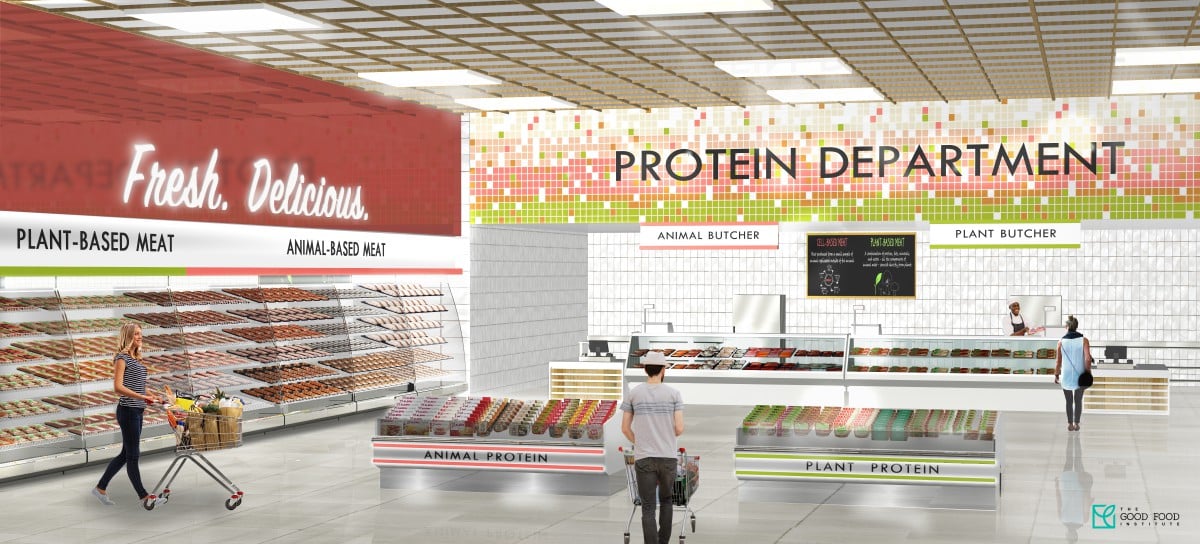We’re moving toward the protein department of the future

Plant-based meats just made the podium. Supermarket chain Bristol Farms is now selling products from plant-based meat purveyor Before the Butcher…well, in the butcher case.
Meanwhile, Giant Food has unveiled an updated shelving paradigm in its newest store—one that carves out a space for plant-based meat in the conventional meat section.

These are more than symbolic steps closer to the future of the meat department. They are crucial moves toward a category tipping point.
We’re on the road to a reimagined meat department—think of it as a protein department where all center-of-plate protein options, whether from a plant or from an animal, can be found in one convenient place.
Challenging the conventions, one category at a time
Beyond Meat changed the game when their flagship product, the Beyond Burger, hit grocery stores in 2016. Not content to be relegated to the frozen land of veggie burgers, Beyond Meat held firm that any retailer selling the Beyond Burger had to shelve it in the refrigerated section right alongside conventional meat. After all, Beyond Meat’s target consumers are meat eaters, and that’s where they shop.
While new for the plant-based meat category, this shelving arrangement was not unprecedented. Plant-based milk had been kicking it in the dairy case since the early 2000s. But it wasn’t always that way. Plant-based milk used to be sequestered in aseptic packaging in an obscure center aisle, where only dedicated plant enthusiasts knew to find them.
Then Silk (Soy + milk = Silk) began using gable-top cartons that could be shelved right alongside cow’s milk in the refrigerated case—where the vast majority of consumers shop for products to put in their coffee and on their cereal. Natural foods retailers began to shelve Silk this way and sales quickly took off, proving the model. Other stores and more brands were quick to follow suit.
Non-dairy milks have been around for hundreds of years, but for only the past two decades have American shoppers been able to find these options conveniently located alongside skim, 2%, and whole milk. This simple change revolutionized the plant-based milk category.
Shifting the market
The 90 plus percent of consumers who aren’t vegan or vegetarian are now familiar with and able to access plant-based milk choices, and a full 37 percent of households in the United States now purchase plant-based milk.
It turns out you don’t have to be vegan to eat (or drink) more plants. In fact, the broad consumer base for plant-based foods includes everyone from the die-hard vegan to the eco-aware omnivore to the average Joe in search of variety. Plant-based milk sales have grown to account for 13 percent of all U.S. retail milk sales, above the commonly cited 10 percent tipping point. And today 88 percent of that purchasing volume comes from the refrigerated section and just 12 percent from the shelf-stable section in the center of the store. (Compare this to zero and 100 percent about 20 years ago.)
Plant-based meat appears to be on the same trajectory. Along with the Beyond Burger and Before the Butcher’s plant-based meats, The Jackfruit Company’s smoked pulled jackfruit has found a home in the refrigerated meat case. Building on this success, many other brands are working toward the same placement.

Plant-based meat currently accounts for just about 1 percent of all U.S. retail meat sales, but consider the opportunity when plant-based meat’s market share reaches parity with plant-based milk’s: At 13 percent of the U.S. retail meat market, plant-based meat retail sales would be worth over $10 billion. All signs are pointing in that direction. Retailers who want to take advantage of this accelerating opportunity in plant-based meat (U.S. retail sales grew 23 percent over a 12-month period last year) should look to the lesson of plant-based milk and shelve plant-based meat products where the bulk of consumers can discover them—right next to the conventional animal-based options. Just picture the dairy case.
Or better yet, picture the protein department of tomorrow.


